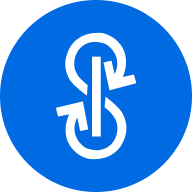
T
Threshold Network Token-pris
$0,016130
-$0,00075
(−4,45 %)
Prisförändring de senaste 24 timmarna

Hur känner du för T idag?
Dela dina känslor här genom att göra tummen upp om du känner dig bullish för coin eller tummen ner om du känner dig bearish.
Rösta för att visa resultat
Threshold Network Token marknadsinfo
Marknadsvärde
Marknadsvärde beräknas genom att multiplicera det cirkulerande utbudet av ett coin med dess senaste pris.
Börsvärde = Cirkulerande utbud × Senaste pris
Börsvärde = Cirkulerande utbud × Senaste pris
Cirkulerande utbud
Totalt belopp för ett coin som är allmänt tillgängligt på marknaden.
Marknadsvärde-rankning
Ett coins rankning i termer av marknadsvärde.
Högsta någonsin
Högsta pris ett coin har nått i sin handelshistorik.
Lägsta någonsin
Lägsta pris ett coin har nått i sin handelshistorik.
Marknadsvärde
$163,43M
Cirkulerande utbud
10 126 069 957 T
90,77 % av
11 155 000 000 T
Marknadsvärde-rankning
136
Granskningar

Senaste granskningen: 20 nov. 2021
Högsta priset under 24 tim
$0,016940
Lägsta priset under 24 tim
$0,016040
Högsta någonsin
$0,16900
−90,46 % (-$0,15287)
Senast uppdaterad: 3 apr. 2022
Lägsta någonsin
$0,014600
+10,47 % (+$0,0015300)
Senast uppdaterad: 11 mars 2025
T-kalkylator


Threshold Network Token-prisresultat i USD
Aktuellt pris på Threshold Network Token är $0,016130. Under de senaste 24 timmarna har Threshold Network Token minskade med −4,44 %. Det har för närvarande ett cirkulerande utbud av 10 126 069 957 T och ett maximalt utbud av 11 155 000 000 T, vilket ger ett marknadsvärde efter full utspädning på $163,43M. För tillfället innehar Threshold Network Token-coin position 136 i marknadsvärdesrankningar. Threshold Network Token/USD-priset uppdateras i realtid.
Idag
-$0,00075
−4,45 %
7 dagar
-$0,00021
−1,29 %
30 dagar
-$0,00270
−14,34 %
3 månader
-$0,01230
−43,27 %
Populära Threshold Network Token-omvandlingar
Senast uppdaterad: 2025-03-28 22:49
| 1 T till USD | 0,016140 $ |
| 1 T till EUR | 0,014929 € |
| 1 T till PHP | 0,92585 ₱ |
| 1 T till IDR | 267,79 Rp |
| 1 T till GBP | 0,012457 £ |
| 1 T till CAD | 0,023096 $ |
| 1 T till AED | 0,059282 AED |
| 1 T till VND | 412,79 ₫ |
Om Threshold Network Token (T)
- Officiell webbplats
- Block explorer
Om tredjeparts webbplatser
Om tredjeparts webbplatser
Genom att använda tredjepartswebbplatsen (”TPW”) samtycker du till att all användning av TPW kommer att omfattas av och styras av villkoren i TPW. Om inte annat uttryckligen anges skriftligen är OKX och dess affiliates (”OKX”) inte på något sätt associerade med ägaren eller operatören av TPW. Du samtycker till att OKX inte är ansvarigt eller skadeståndsskyldigt för förlust, skada eller andra konsekvenser som uppstår till följd av din användning av TPW. Var medveten om att användning av en TPW kan leda till förlust eller minskning av dina tillgångar.
Vanliga frågor för Threshold Network Token
Hur mycket är 1 Threshold Network Token värd idag?
För närvarande är en Threshold Network Token värd $0,016130. För svar och insikt om prisåtgärder för Threshold Network Token är du på rätt plats. Utforska de senaste diagrammen för Threshold Network Token och handla ansvarsfullt med OKX.
Vad är kryptovalutor?
Kryptovalutor, till exempel Threshold Network Token, är digitala tillgångar som fungerar på en offentlig reskontra som kallas blockkedjor. Läs mer om coins och tokens som erbjuds på OKX och deras olika attribut, som inkluderar live-priser och realtidsdiagram.
När uppfanns kryptovalutor?
Tack vare finanskrisen 2008 ökade intresset för decentraliserad finansiering. Bitcoin erbjöd en ny lösning genom att vara en säker digital tillgång på ett decentraliserat nätverk. Sedan dess har många andra tokens som t.ex. Threshold Network Token skapats också.
Kommer priset på Threshold Network Token gå upp idag?
Se vår Threshold Network Token prisprognossida för att förutse framtida priser och fastställa dina prismål.
ESG-upplysning
ESG-regleringar (Environmental, Social och Governance) för kryptotillgångar syftar till att ta itu med eventuell miljöpåverkan (t.ex. energiintensiv mining), främja transparens och säkerställa etiska förvaltningsmetoder för att anpassa kryptoindustrin till bredare hållbarhets- och samhälleliga mål. Dessa regleringar uppmuntrar efterlevnad av standarder som minskar risker och främjar förtroende för digitala tillgångar.
Tillgångsdetaljer
Namn
OKcoin Europe LTD
Relevant juridisk enhetsidentifierare
54930069NLWEIGLHXU42
Namn på kryptotillgången
Threshold
Konsensusmekanism
The Ethereum network uses a Proof-of-Stake Consensus Mechanism to validate new transactions on the blockchain. Core Components 1. Validators: Validators are responsible for proposing and validating new blocks. To become a validator, a user must deposit (stake) 32 ETH into a smart contract. This stake acts as collateral and can be slashed if the validator behaves dishonestly. 2. Beacon Chain: The Beacon Chain is the backbone of Ethereum 2.0. It coordinates the network of validators and manages the consensus protocol. It is responsible for creating new blocks, organizing validators into committees, and implementing the finality of blocks. Consensus Process 1. Block Proposal: Validators are chosen randomly to propose new blocks. This selection is based on a weighted random function (WRF), where the weight is determined by the amount of ETH staked. 2. Attestation: Validators not proposing a block participate in attestation. They attest to the validity of the proposed block by voting for it. Attestations are then aggregated to form a single proof of the block’s validity. 3. Committees: Validators are organized into committees to streamline the validation process. Each committee is responsible for validating blocks within a specific shard or the Beacon Chain itself. This ensures decentralization and security, as a smaller group of validators can quickly reach consensus. 4. Finality: Ethereum 2.0 uses a mechanism called Casper FFG (Friendly Finality Gadget) to achieve finality. Finality means that a block and its transactions are considered irreversible and confirmed. Validators vote on the finality of blocks, and once a supermajority is reached, the block is finalized. 5. Incentives and Penalties: Validators earn rewards for participating in the network, including proposing blocks and attesting to their validity. Conversely, validators can be penalized (slashed) for malicious behavior, such as double-signing or being offline for extended periods. This ensures honest participation and network security.
Incitamentmekanismer och tillämpliga avgifter
Ethereum, particularly after transitioning to Ethereum 2.0 (Eth2), employs a Proof-of-Stake (PoS) consensus mechanism to secure its network. The incentives for validators and the fee structures play crucial roles in maintaining the security and efficiency of the blockchain. Incentive Mechanisms 1. Staking Rewards: Validator Rewards: Validators are essential to the PoS mechanism. They are responsible for proposing and validating new blocks. To participate, they must stake a minimum of 32 ETH. In return, they earn rewards for their contributions, which are paid out in ETH. These rewards are a combination of newly minted ETH and transaction fees from the blocks they validate. Reward Rate: The reward rate for validators is dynamic and depends on the total amount of ETH staked in the network. The more ETH staked, the lower the individual reward rate, and vice versa. This is designed to balance the network's security and the incentive to participate. 2. Transaction Fees: Base Fee: After the implementation of Ethereum Improvement Proposal (EIP) 1559, the transaction fee model changed to include a base fee that is burned (i.e., removed from circulation). This base fee adjusts dynamically based on network demand, aiming to stabilize transaction fees and reduce volatility. Priority Fee (Tip): Users can also include a priority fee (tip) to incentivize validators to include their transactions more quickly. This fee goes directly to the validators, providing them with an additional incentive to process transactions efficiently. 3. Penalties for Malicious Behavior: Slashing: Validators face penalties (slashing) if they engage in malicious behavior, such as double-signing or validating incorrect information. Slashing results in the loss of a portion of their staked ETH, discouraging bad actors and ensuring that validators act in the network's best interest. Inactivity Penalties: Validators also face penalties for prolonged inactivity. This ensures that validators remain active and engaged in maintaining the network's security and operation. Fees Applicable on the Ethereum Blockchain 1. Gas Fees: Calculation: Gas fees are calculated based on the computational complexity of transactions and smart contract executions. Each operation on the Ethereum Virtual Machine (EVM) has an associated gas cost. Dynamic Adjustment: The base fee introduced by EIP-1559 dynamically adjusts according to network congestion. When demand for block space is high, the base fee increases, and when demand is low, it decreases. 2. Smart Contract Fees: Deployment and Interaction: Deploying a smart contract on Ethereum involves paying gas fees proportional to the contract's complexity and size. Interacting with deployed smart contracts (e.g., executing functions, transferring tokens) also incurs gas fees. Optimizations: Developers are incentivized to optimize their smart contracts to minimize gas usage, making transactions more cost-effective for users. 3. Asset Transfer Fees: Token Transfers: Transferring ERC-20 or other token standards involves gas fees. These fees vary based on the token's contract implementation and the current network demand.
Början av den period som upplysningen avser
2024-03-26
Slutet av den period som upplysningen avser
2025-03-26
Energirapport
Energiförbrukning
2474.23322 (kWh/a)
Energiförbrukningskällor och -metoder
The energy consumption of this asset is aggregated across multiple components:
To determine the energy consumption of a token, the energy consumption of the network(s) ethereum is calculated first. Based on the crypto asset's gas consumption per network, the share of the total consumption of the respective network that is assigned to this asset is defined. When calculating the energy consumption, we used - if available - the Functionally Fungible Group Digital Token Identifier (FFG DTI) to determine all implementations of the asset of question in scope and we update the mappings regulary, based on data of the Digital Token Identifier Foundation.
Friskrivningsklausul
Det sociala innehållet på den här sidan (”Innehåll”), inklusive men inte begränsat till tweets och statistik som tillhandahålls av LunarCrush, kommer från tredje part och tillhandahålls ”i befintligt skick” endast i informationssyfte. OKX garanterar inte kvaliteten eller riktigheten i innehållet, och innehållet representerar inte OKX:s åsikter. Det är inte avsett att ge (i) investeringsrådgivning eller rekommendation; (ii) ett erbjudande eller en uppmaning att köpa, sälja eller inneha digitala tillgångar; eller (iii) finansiell, redovisningsmässig, juridisk eller skatterådgivning. Digitala tillgångar, inklusive stabila kryptovalutor och NFT, innebär en hög grad av risk och kan fluktuera kraftigt. Priset och utvecklingen för de digitala tillgångarna garanteras inte och kan förändras utan förvarning. OKX tillhandahåller inte investerings- eller tillgångsrekommendationer. Du bör noga överväga om handel med eller innehav av digitala tillgångar är lämpligt för dig mot bakgrund av din ekonomiska situation. Kontakta din juridiska/skatte-/investeringsexpert om du har frågor om dina specifika omständigheter. För ytterligare information, se våra Användarvillkor och Riskvarning. Genom att använda tredje parts webbplats (”TPW”) accepterar du att all användning av TPW kommer att vara föremål för och styras av villkoren i TPW. Om inte annat uttryckligen anges skriftligen är OKX och dess dotterbolag (”OKX”) inte på något sätt associerade med ägaren eller operatören av TPW. Du samtycker till att OKX inte är ansvarigt eller skadeståndsskyldigt för förlust, skada eller andra konsekvenser som uppstår till följd av din användning av TPW. Var medveten om att användning av en TPW kan leda till förlust eller minskning av dina tillgångar. Produkten kanske inte är tillgänglig i alla jurisdiktioner.
T-kalkylator












